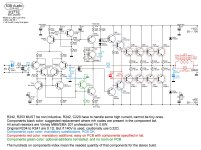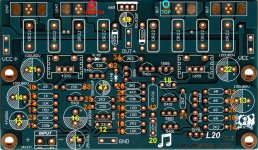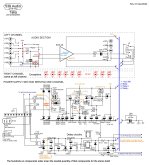Hi PANDINUS,
The resistive layer is highly damped and offers no inductive effect. The coating is not magnetic in nature, except in the case of a wire wound. Even then, the wire may be non-ferrous, but could be steel. It would also be resistive and therefore highly damped.
There isn't enough material to cause distortion in the output coil. The practical effect is zero at audio frequencies. At very high frequencies the inductance of the coil would be so high, distortion (whatever tiny amount) is the very least of your problems.
Basically, there isn't enough ferrous material in a wire wound to cause problems. Especially compared to everything else. Any small effect is being blow way out of proportion here.
The resistive layer is highly damped and offers no inductive effect. The coating is not magnetic in nature, except in the case of a wire wound. Even then, the wire may be non-ferrous, but could be steel. It would also be resistive and therefore highly damped.
There isn't enough material to cause distortion in the output coil. The practical effect is zero at audio frequencies. At very high frequencies the inductance of the coil would be so high, distortion (whatever tiny amount) is the very least of your problems.
Basically, there isn't enough ferrous material in a wire wound to cause problems. Especially compared to everything else. Any small effect is being blow way out of proportion here.
Pandinus is right, try to check the resistor with a magnet! It seems to be not negligible at all.
When I got the schematic from the PCB, I forgot to consider a 2.2KΩ resistor, the one around the center/top of the PCB. This resistor I named R234 now, is one of the two I added in red on the last schematic.
So here is the schematic updated, and the PCB with component numbers.
Please FORGET the old schematic and take this one as a reference.
R251 and C151 must be soldered between the bases of the final pairs, the closest points are referred to with the letter "O", one bottom side (left of the board - red), and the other on the top side (right - cyan).
Caution when using a voltage close to 140V: one of the small transistors (I don't remember which one), becomes too hot, check it out. I will discover and report it when I build this amp with 140V, perhaps next fall.
To answer Radian's question: Yes, you could mount only one final pair to drive a 5W compression driver and use 50V/60V total voltage.
So here is the schematic updated, and the PCB with component numbers.
Please FORGET the old schematic and take this one as a reference.
R251 and C151 must be soldered between the bases of the final pairs, the closest points are referred to with the letter "O", one bottom side (left of the board - red), and the other on the top side (right - cyan).
Caution when using a voltage close to 140V: one of the small transistors (I don't remember which one), becomes too hot, check it out. I will discover and report it when I build this amp with 140V, perhaps next fall.
To answer Radian's question: Yes, you could mount only one final pair to drive a 5W compression driver and use 50V/60V total voltage.
Attachments
Measure the inductance with and without the resistor. Then for the real test, measure distortion with and without. Whatever you come up with it the truth.
The first inductor that came in handy is 14.5µH; with the resistors, the value barely moves to 14.6. So you're right! But I'm surprised how strongly a magnet attracts the resistor, not on only the caps, which would be normal, but the center. It has to be considered the mass of the magnetic parts of the resistor is very negligible. Thank you!
Distance is one factor. But the magnet works on the entire length and has a much higher field intensity. And then again, the amount of hysteresis is small as well. In other words, doesn't amount to anything in the real world.
Just catching up on this thread. I have LJM’s MX50SE amps. These also use 5551 transistors with altered pinouts as here from CDIL https://static1.squarespace.com/sta...cd98528f917f8fb66b62/1662176667565/2N5551.pdf
Are CDIL considered a legitimate source for components?
Are CDIL considered a legitimate source for components?
Inner. check it here: https://www.circuits.dk/calculator_single_layer_aircore.htmFor L251 are we talking about inner or outer diameter?
Salve Marigno! È bello rivederti!
Somewhere else in earlier posts here I've found a post indicating that CDIL 2SA970 has low noise too.
So, I think CDIL transistors are fine.
Also, transistors in Chinese kits seem to be fine. Especially LJM kits. Good components. I'm not talking about these separately sold transistors which are very likely fakes. Transistors in kits are good products. I'm not talking about trade marks but about actual performance. Though, at least for output I use Toshiba/ON Semis.
After all, production of transistors isn't rocket science. Hardworking and industrious people from far east learn just like Japanese once did.
A year ago I have tested CDIL 2SA970/2SC2240 with curve tracer. Conclusion: Good products.No experience with CDIL personally, but others seem to think they are fine.
Somewhere else in earlier posts here I've found a post indicating that CDIL 2SA970 has low noise too.
So, I think CDIL transistors are fine.
Also, transistors in Chinese kits seem to be fine. Especially LJM kits. Good components. I'm not talking about these separately sold transistors which are very likely fakes. Transistors in kits are good products. I'm not talking about trade marks but about actual performance. Though, at least for output I use Toshiba/ON Semis.
After all, production of transistors isn't rocket science. Hardworking and industrious people from far east learn just like Japanese once did.
Ciao Berlusconi! Grazie per l'apprezzamento!
I ceased posting news about my preamplifiers because of some Mona Lisa admirers posting nonsense, who think it is possible to build a gain stage without any distortion. They want to look at Mona Lisa without sunglasses (distortion), ending up looking at Mona Lisa who wears sunglasses herself.
These people do not deserve to learn anything more than they already know, because they know everything. But none of them came here to explain how such a gain stage can be built. Or, at least, show us how they built a Carnot Engine, which is the same.
Nevertheless, I forced myself to start this thread because this power amp deserved its one. If I knew this amp better, I never would have started modifying the Dartzeel NHB-108 to get a DTB.
It is very simple to assemble, because it has its own PCB, and the modifications are very simple to apply.
It is one of the best power amps I've heard among the ones whose bandpass is widened using the feedback.
Monna Lisa fans: this is far out of your scope, forget what you read. Beware the dog! High distortion here.
I ceased posting news about my preamplifiers because of some Mona Lisa admirers posting nonsense, who think it is possible to build a gain stage without any distortion. They want to look at Mona Lisa without sunglasses (distortion), ending up looking at Mona Lisa who wears sunglasses herself.
These people do not deserve to learn anything more than they already know, because they know everything. But none of them came here to explain how such a gain stage can be built. Or, at least, show us how they built a Carnot Engine, which is the same.
Nevertheless, I forced myself to start this thread because this power amp deserved its one. If I knew this amp better, I never would have started modifying the Dartzeel NHB-108 to get a DTB.
It is very simple to assemble, because it has its own PCB, and the modifications are very simple to apply.
It is one of the best power amps I've heard among the ones whose bandpass is widened using the feedback.
Monna Lisa fans: this is far out of your scope, forget what you read. Beware the dog! High distortion here.
Dear Marigno, just a friendly advice: ignore the nonsense and you will remain at the side of reason, that's all you need. The art of life is to deal just with the only thing that is under your control: your thoughts. Hubris of ignorant people is invincible - let it go.I ceased posting news about my preamplifiers because of some Mona Lisa admirers posting nonsense
I would like very much to read your posts more often in the future.
Have pleasant Holidays.
I thank you for your advice and your consideration of me.
Let's do this way: I will search for posts of those people, publish their names, and then restart posting some good stuff.
Buone vacanze!
Let's do this way: I will search for posts of those people, publish their names, and then restart posting some good stuff.
Buone vacanze!
Don't waste your time. Let it go!I will search for posts of those people, publish their names...
Tat's a great idea. I was missing your inspiring thoughts.... and then restart posting some good stuff
Happy Easter! Let's celebrate new beginnings.Buone vacanze!
I must say you're right, it would be a waste of time.
I'll think about publishing new boring distorting signal processors.
Buona Pasqua!!!
I'll think about publishing new boring distorting signal processors.
Buona Pasqua!!!
Ok guys did all the mods according to the last schematic.
Associated equipment as follows:
Wiim Ultra USB out into China Fifo DDC into
Chinese R2R DAC. On the DAC all opamps are removed going straight from the resistor ladder into the discreete part( opamp removed) of the Chinese Accuphase clone preamp, from there into modded Cary SLP 90 clone tube buffer into Marigno modded LJM 10. No coupling caps on amp as tube pre got those on the output. Speakers at the moment are Quad 21L.
After about 30 hours I can already attest it's a step up from the stock unit. I'm not very good at describing sound impressions but I try to communicate what I hear:
Bass definition and precision is top notch.
All instruments of an orchestra have a realism that is rarely heard even on expensive gear. Pinpoint imaging and soundscape is phantastic although that is mainly due to the excellent Tube pre.
My search for a good amp has certainly ended right here. D-Amps have reached an amazing quality especially when you get rid of their opamp based pre stage. I enjoyed fiddling with them but this modded LJM 10 9.2 board is a good step up in sonics.
I'm curious now how marignos preamps would stack up to my Cary SLP 90 tube pre clone?
Klaus
Associated equipment as follows:
Wiim Ultra USB out into China Fifo DDC into
Chinese R2R DAC. On the DAC all opamps are removed going straight from the resistor ladder into the discreete part( opamp removed) of the Chinese Accuphase clone preamp, from there into modded Cary SLP 90 clone tube buffer into Marigno modded LJM 10. No coupling caps on amp as tube pre got those on the output. Speakers at the moment are Quad 21L.
After about 30 hours I can already attest it's a step up from the stock unit. I'm not very good at describing sound impressions but I try to communicate what I hear:
Bass definition and precision is top notch.
All instruments of an orchestra have a realism that is rarely heard even on expensive gear. Pinpoint imaging and soundscape is phantastic although that is mainly due to the excellent Tube pre.
My search for a good amp has certainly ended right here. D-Amps have reached an amazing quality especially when you get rid of their opamp based pre stage. I enjoyed fiddling with them but this modded LJM 10 9.2 board is a good step up in sonics.
I'm curious now how marignos preamps would stack up to my Cary SLP 90 tube pre clone?
Klaus
Hi Klaus, I'm glad you like this power amp!
The preamplifier I'm using currently, named Talia, is here:
from post #57.
I haven't posted any updates yet because the final thing needs a new thread to avoid confusion, like I did for this L20 9.2 project.
I made some other hybrid preamplifiers with a triode (I used the VT37 and VT76 too) as a gain stage, and a mosfet as a follower.
Among tube and mosfet as followers, I prefer mosfet, far better than tube IMHO. I also prefer SiC diodes to tube diodes as rectifiers because to me they are identical, and SiCs do not have any heater to feed!
As a power supply for preamps, I always use the "Virtual Battery" topology in my interpretation. You can see it in the thread I mentioned above, but now it is greatly improved; take a look at its schematic here.
Be aware that all preamplifiers of mine, like your Cary SLP 90 (and Conrad Johnson GAT too), are inverting, so to restore the original phase (if you are sensitive to this), you have to swap the speaker connections.
The preamplifier I'm using currently, named Talia, is here:
I finally managed to close the projects of my “WOTS LeGrand” and “WOTS Tre” line pre-amplifiers.
Two very well-functioning pre-amplifiers, necessary for the optimal definition of the sound, before sending it to the power amps. Or two useless and boring post-amplifiers, according to the opinion of some of the readers.
Both are dual-mono builds and have the same warm and precise sound, even if they use different technologies: the LeGrand is hybrid (tube/transistor), and the Tre is completely solid state.
The electronic part uses symmetrically designed double-sided PCBs, a single PCB design...
Two very well-functioning pre-amplifiers, necessary for the optimal definition of the sound, before sending it to the power amps. Or two useless and boring post-amplifiers, according to the opinion of some of the readers.
Both are dual-mono builds and have the same warm and precise sound, even if they use different technologies: the LeGrand is hybrid (tube/transistor), and the Tre is completely solid state.
The electronic part uses symmetrically designed double-sided PCBs, a single PCB design...
- marigno
- Replies: 103
- Forum: Analog Line Level
I haven't posted any updates yet because the final thing needs a new thread to avoid confusion, like I did for this L20 9.2 project.
I made some other hybrid preamplifiers with a triode (I used the VT37 and VT76 too) as a gain stage, and a mosfet as a follower.
Among tube and mosfet as followers, I prefer mosfet, far better than tube IMHO. I also prefer SiC diodes to tube diodes as rectifiers because to me they are identical, and SiCs do not have any heater to feed!
As a power supply for preamps, I always use the "Virtual Battery" topology in my interpretation. You can see it in the thread I mentioned above, but now it is greatly improved; take a look at its schematic here.
Be aware that all preamplifiers of mine, like your Cary SLP 90 (and Conrad Johnson GAT too), are inverting, so to restore the original phase (if you are sensitive to this), you have to swap the speaker connections.
Attachments
- Home
- Amplifiers
- Solid State
- LJM L20 V9.2 main amp


